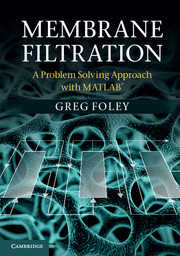Book contents
- Frontmatter
- Dedication
- Contents
- Preface
- Abbreviations
- 1 Introduction to membrane filtration of liquids
- 2 Dead-end filtration
- 3 Crossflow microfiltration
- 4 Ultrafiltration flux theories
- 5 Ultrafiltration process analysis and design at the limiting flux
- 6 Diafiltration at the limiting flux
- 7 Ultrafiltration and diafiltration with incomplete rejection
- 8 The osmotic pressure model applied to ultrafiltration and diafiltration
- 9 Reverse osmosis and nanofiltration
- 10 Membrane fouling
- Appendix Mathematical and computational background
- Index
- References
9 - Reverse osmosis and nanofiltration
Published online by Cambridge University Press: 05 July 2013
- Frontmatter
- Dedication
- Contents
- Preface
- Abbreviations
- 1 Introduction to membrane filtration of liquids
- 2 Dead-end filtration
- 3 Crossflow microfiltration
- 4 Ultrafiltration flux theories
- 5 Ultrafiltration process analysis and design at the limiting flux
- 6 Diafiltration at the limiting flux
- 7 Ultrafiltration and diafiltration with incomplete rejection
- 8 The osmotic pressure model applied to ultrafiltration and diafiltration
- 9 Reverse osmosis and nanofiltration
- 10 Membrane fouling
- Appendix Mathematical and computational background
- Index
- References
Summary
Introduction to reverse osmosis
Reverse osmosis (RO) is the membrane filtration of solutions of low molecular weight solutes, especially salts [1]. At this small scale, it is appropriate to discard the idea of the membrane having distinct pores but instead to view it as a matrix through which both the solvent and solute diffuse. Diffusion occurs through the space between the chains of the polymer from which the membrane is constructed. However, the membrane may contain a small number of defects resulting in the presence of some pores.
The ability of a species to diffuse through an RO membrane is typically controlled by charge effects rather than size and, consequently, RO is used extensively for desalination processes. It is also used for water softening, i.e., removal of cations, especially calcium, and in production of high purity water such as that required in electronics industries. Smaller scale RO units are often used to produce high purity water for laboratory purposes.
Just like ultrafiltration, the flux of pure water through RO membranes is partly limited by the osmotic pressure of the solution. Osmotic pressure is a colligative property, meaning that at a fixed mass concentration, it increases as the molecular weight of the solute decreases. In other words, the osmotic pressure depends on the number of solute molecules per unit volume. Thus, the osmotic pressures of salt solutions are much greater than those of macromolecular solutions at the same molar concentration. This contributes to the need for the very high pressures, up to 100 bar, that are used in RO.
- Type
- Chapter
- Information
- Membrane FiltrationA Problem Solving Approach with MATLAB, pp. 253 - 272Publisher: Cambridge University PressPrint publication year: 2013
References
- 1
- Cited by



